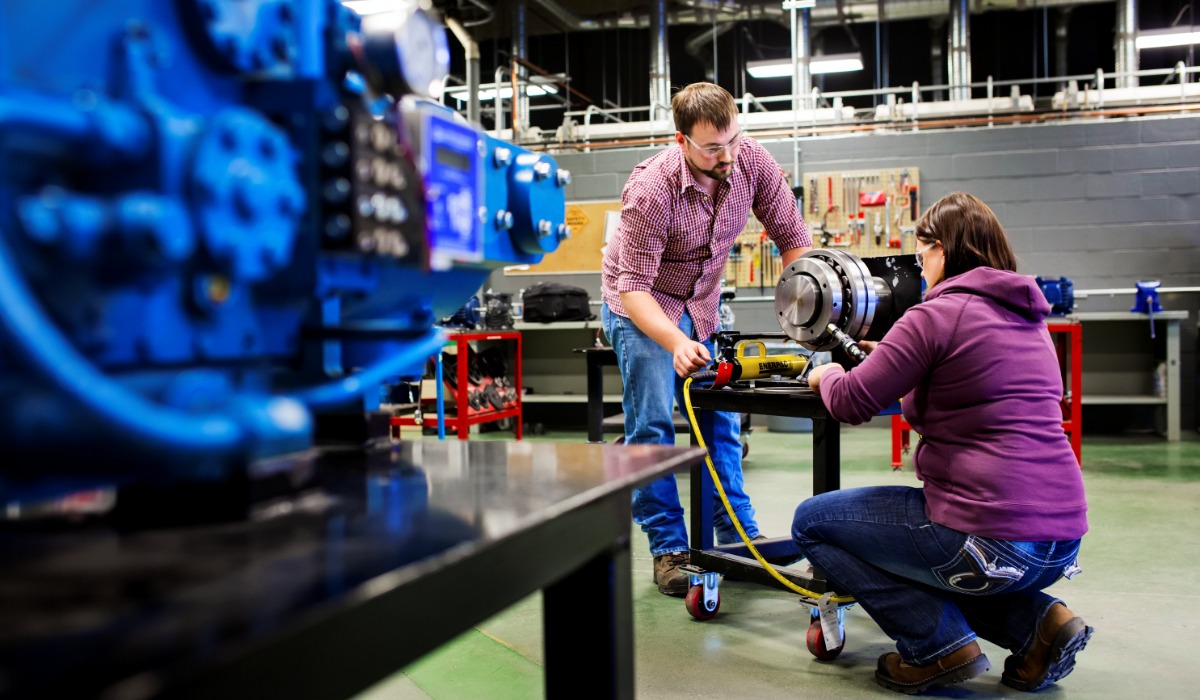Overview
Embark on a fulfilling career as a machinist, playing a pivotal role in manufacturing and repairing parts and components critical to industries such as manufacturing, transportation, energy and healthcare.
This comprehensive 12-week Pre-employment Machinist program combines hands-on shop experience with theoretical knowledge curated by industry experts to address the unique demands of manufacturing environments.
In this program, you will:
- receive rigorous training in standard safety protocols
- master the mathematical concepts and calculations essential for precision machining
- learn to operate computer numerical control (CNC) machines, understand programming and execution
- gain proficiency in using lathes for cutting, sanding, drilling, facing and turning
- acquire skills in operating drill presses for producing accurate holes in metal
- learn milling, grinding and other machining techniques.
Once you graduate, you'll possess the foundational skills to gain employment and register as an apprentice, positioning you ahead in the competitive field of machining.
With this program, you're not just learning a trade - you're setting the stage for a career as a machinist.
Machinists tend to be objective, innovative and methodical.
You need:
- mechanical aptitude
- critical thinking and problem-solving skills
- the ability to use your hands skillfully and quickly
- the ability to estimate and measure sizes and distances accurately
- the ability to work alone on tasks that require concentration and physical effort.
You should enjoy doing creative work with machinery that requires a high degree of skill and precision.
This program aligns with the first period of Alberta Apprenticeship and Industry Training's (AIT) Machinist curriculum.
Graduates are eligible to register as apprentices and challenge the first-period exam.
Once you pass the exam and complete the necessary training hours with an employer, you may register for SAIT's Machinist apprenticeship program beginning in period two.
Graduates are also eligible to receive course credit for all first-semester classes in our Machinist Technology diploma program.
Upon successful completion of this program, you'll receive a SAIT Pre-Employment Machinist certificate.
Careers and opportunities
Our graduates may work in the following occupations. Some careers require additional experience and education.
Career planning support
Unsure which career path is for you? Here are some recommended career planning resources to help you decide your future.
You can also head to Alberta alis for lots of information about careers in Alberta, including quizzes and labour market information to help you narrow down a path.
Finally, you can take our online career finder quiz, which can help narrow your options based on your current skills and interests.
Courses
The Pre-Employment Machinist certificate requires credits (13.5 courses) to complete.
| Course | Credits |
|---|---|
|
This course introduces you to the fundamentals of reading manufacturing blueprints, including sketching and dimensioning objects in an orthographic projection. You'll explore isometric drawings and sections, and you'll interpret machine shop drawings containing applied print reading terminology. You'll also examine the use of manufacturing symbols, assembly drawings, and geometric dimensioning and tolerancing. Finally, you'll learn how computer-aided design and manufacturing (CAD/CAM) is used for turning, and you'll describe the use of fasteners and locking devices. |
1.5 |
|
Provides the learner with the opportunities to develop skills in the safe and efficient use of hand tools for measurement, layout, metal cutting and assembly work. Learners will also operate pedestal grinders, drilling machines, power saws, engine lathes, drilling machines and milling machines. Basic heat treatment will also be included. Also, this course introduces safe working habits while working with and around oxy-fuel gas cutting and welding processes. |
3 |
|
This course introduces you to the fundamental theory you'll need to work safely and effectively as a machinist. You'll begin by examining important safety regulations, as well as procedures for working with hazardous materials, and for climbing, lifting, rigging and hoisting. You'll examine taper systems, screw threads and measuring tools, as well as the lubricants and cutting fluids used in the trade. You'll also explore the types and operating procedures of a variety of tools and equipment, including oxy-fuel tools, hand tools, layout tools, drills, drilling machines, power saws, lathes and grinders. |
3 |
|
This course introduces you to the fundamental mathematical principles that you will need to meet the requirements of your program. You'll explore the trade applications of whole numbers, fractions and decimals, as well as metric and imperial conversion and geometric problems. You'll perform algebraic operations and use ratios, proportions and percentages to solve trade-related problems. |
1.5 |
|
In this course, you'll learn how to manually program and safely operate computer numerical control (CNC) turning centres, including using control panel functions, performing system setup and manipulating offsets. You'll also get hands-on experience building and executing a series of lathe profiles to meet specifications. |
3 |
|
In this course, you'll learn the basic theory necessary to operate computer numerical control (CNC) turning centres. You'll explore the safety procedures, basic concepts and applications of CNC machines, as well as the purpose of co-ordinate and reference points used for CNC machining. You'll analyze the structure of the CNC format and code structure and you'll execute and verify manual programs. Finally, you'll examine CNC turning machine setups and offsets. |
1.5 |
Progression
You must attain a PGPA and/or a CGPA of 2.0 or better each semester and pass the prerequisite courses to progress through the program.
To qualify for graduation, you must pass all courses, attain a CGPA of 2.0 or better and complete course requirements within the prescribed timelines.
Admission requirements
Applicants educated in Canada
Applicants must demonstrate English language proficiency and completion of the following courses or equivalents:
- at least 50% in Math 20-1, Math 20-2 or Math 20-3, and
- at least 50% in English Arts 20-1 or English Arts 20-2, and
- at least 50% in Science 10.
SAIT accepts high school course equivalents for admission for applicants educated outside Alberta.
All applicants who were educated outside of Canada must demonstrate English language proficiency and provide proof they meet the program admission requirements outlined above with an international document assessment. Find accepted educational documents and assessment options.
SAIT may also accept courses completed at certain international post-secondary institutions.
Academic Upgrading
Missing an admission requirement for this program? Upgrade your prior education to help you receive admission into one of SAIT's career programs.
English language proficiency
All applicants must demonstrate English language proficiency prior to admission, including students educated in Canada.
Transfer agreements
At SAIT, we have created transfer agreements with partner institutions to allow you to earn course credits toward your SAIT program based on your previously completed credentials.
Transfer Alberta search tool
Use the Transfer Alberta search tool to see all transfer agreements between Alberta post-secondary institutions (including those with the University of Calgary, Mount Royal University and Bow Valley College.)
Search transfer agreements in Alberta
Transfer options for graduates
When you have completed this program, you may continue your education at a partner post-secondary institution. These transfer agreements include partnerships within and/or outside of Canada.
Available intakes
Fall 2026
Start dates:
- Domestic students: Open
-
-
Application deadline: June 30, 2026
-
Costs
2025/26 tuition and fees
The following estimated costs are effective as of July 1, 2025.
The estimated total cost of tuition and fees is based on completing the program within 12 weeks. Following a modified schedule will impact the fees you pay per semester and may alter final costs.
Domestic students
**Students in this program do not qualify for the UPass or health and dental plans, nor do they pay Saitsa fees.
Books and supplies are approximately $1,000 - $1,500 per full-time year.
This is a bring-your-own-device program with a standard computer hardware and software requirement. See the specific requirements on our computers and laptops page.
Find your booklist on the SAIT Bookstore's website. The booklist will be available closer to the program start date.
Can't find your program or course? The bookstore didn't receive a textbook list. Contact your program directly to determine if they're still refining course details or if you're in luck; no textbook purchase is required this term.
Financial aid
Paying for your education may feel overwhelming, but we have resources and programs that can help, including information about payment options, student loans, grants and scholarships.
Application process
Ready to apply?
Follow our step-by-step guide to submitting a successful application.
Communication during admission
Email is the primary source of communication during the selection process. Ensure your personal email account is managed appropriately to receive our emails, files and communications. We recommend you add the ma.info@sait.ca domain to your safe senders' list or you risk missing critical email messages.
Begin your application
Apply now using the online application portal.
Ensure you have a valid Visa or Mastercard to pay the non-refundable application fee of $120 for domestic applicants.
Information sessions
Prepare for a strong start in your chosen program or get the details you need to decide your future path.
Our expert staff and faculty are ready to answer your questions and provide information about the following:
- What sets SAIT apart
- An introduction to the program and area of study
- Admission requirements
- Future career paths
- Information on the earning potential and graduate employment rates.
Contact us
School of Manufacturing and Automation Advising
-
Phone - 403.284.8641
-
Email - ma.info@sait.ca
Subscribe for updates
Your journey starts here! Sign up to get important updates on:
- Manufacturing and automation programs
- Application information
- Relevant news and events

Oki, Âba wathtech, Danit'ada, Tawnshi, Hello.
SAIT is located on the traditional territories of the Niitsitapi (Blackfoot) and the people of Treaty 7 which includes the Siksika, the Piikani, the Kainai, the Tsuut’ina and the Îyârhe Nakoda of Bearspaw, Chiniki and Goodstoney.
We are situated in an area the Blackfoot tribes traditionally called Moh’kinsstis, where the Bow River meets the Elbow River. We now call it the city of Calgary, which is also home to the Métis Nation of Alberta.




